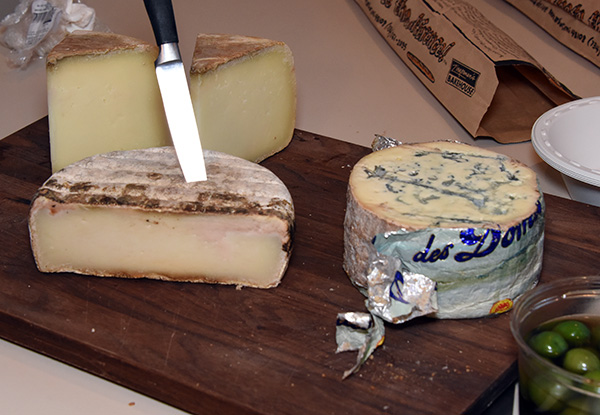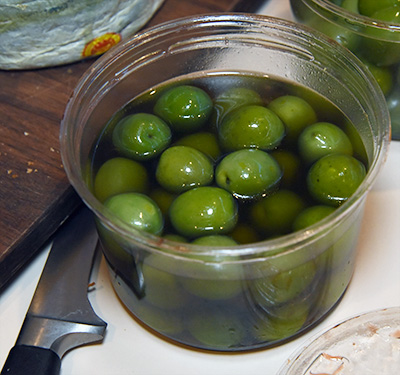Le Tastevin Wine Club - Notes on Cheeses – March 16, 2016
Tonight's cheeses are from Whole Foods in Ann Arbor, and bagettes are baked by Zingermann's bakery.
Since we introduced some smoked meats a few tastings ago,  I thought an interesting compliment for our Hermitage wines would be nocellara del belice olives. These olives are from the vicinity of the town Castelvetrano in the Belice river valley in western Sicily. It takes about 5 years for an olive tree to bear usable fruit, and harvest occurs from October through the middle of November. The particular curing and fermentation style is distinctive to this town, and thus these olives are marketed as "Castelventranos". The olives are harvested young; because chlorophyll levels largely remain viable, they are bright green. Cured in lightly salted lye for a period of 12 hours, they are then thoroughly washed in fresh water and packaged. Refrigeration is necessary to retain the bright green color, otherwise oxidation occurs and they turn greenish-brown. They are slightly salty, sweet, and buttery, but do not overwhelm or overpower food or drink.
I thought an interesting compliment for our Hermitage wines would be nocellara del belice olives. These olives are from the vicinity of the town Castelvetrano in the Belice river valley in western Sicily. It takes about 5 years for an olive tree to bear usable fruit, and harvest occurs from October through the middle of November. The particular curing and fermentation style is distinctive to this town, and thus these olives are marketed as "Castelventranos". The olives are harvested young; because chlorophyll levels largely remain viable, they are bright green. Cured in lightly salted lye for a period of 12 hours, they are then thoroughly washed in fresh water and packaged. Refrigeration is necessary to retain the bright green color, otherwise oxidation occurs and they turn greenish-brown. They are slightly salty, sweet, and buttery, but do not overwhelm or overpower food or drink.
Tomme des Bois Noirs (area of the dark woods), Hervé Mons – raw goat’s milk. Herve Mons took on his parents business and now works with producers from all over France, bringing in a range of over 200 cheeses that are aged in the Mons caves near Lyon France. This cheese is a partnership effort between Hervé Mons and the dairy of Saint Just en Chevalet in 2008 to save a particular dairy and the livelihood of 17 local goat farms from the surrounding mountains in the Pyrenees. The Tomme des Bois Noirs is a natural rind cheese, with a firm but fondant paste. The flavors are clean, and the characteristic goat taste isn’t overwhelming. It has hints of nuts and fresh fruits notes, even people who swear to never eat goat cheese have been eating it.
Fourme d'Ambert (pasteurized cow’s milk) is one of France's oldest cheeses, and dates from as far back as Roman times. Although most often produced with pasteurized milk by industry and Coopératives, more recently artisanal production has begun using raw milk. Made in Auvergne, this cheese is sold in distinct, narrow cylindrical shape. The semi-hard cheese is inoculated with Penicillium roqueforti spores and aged for at least 28 days. The flavor is eggy, rich, and slightly nutty, with distinct notes of heavy cream. It almost tastes of reduced cream: thick, buttery, and full of milky butterfat. Unlike Roquefort, it won't linger with peppery reverberation. Its flavor has notes of dried cherries, mushrooms, fruit and chocolate, pairing well with stronger reds and even sweet fortified wines like port and sherry, even dark, chocolatey ports or stouts. Page last updated: December 18, 2016 (EB)
